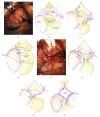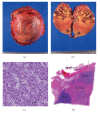Successful surgical resection for peritoneal implantation of hepatocellular carcinoma at the paracardial portion
- PMID: 20049169
- PMCID: PMC2798618
- DOI: 10.1155/2009/231854
Successful surgical resection for peritoneal implantation of hepatocellular carcinoma at the paracardial portion
Abstract
Peritoneal implantation from hepatocellular carcinoma has been rarely reported. It may occur at various sites. Here we present a surgically resected case of peritoneal implantation to the diaphragm from hepatocellular carcinoma. A 50-year-old woman underwent right hemihepatectomy extended to a medial part of Couinaud segment IV for hepatocellular carcinoma in May 2000. In December 2008, the elevation of alpha-phetoprotein and the appearance of a heterogeneously enhanced mass, with dimensions of 9 x 7 cm, and adjacent to the remnant liver and pericardium suggested intrahepatic recurrence with markedly enhanced growth. After transcatheter arterial embolization, surgical resection under laparotomy combined with median sternotomy was selected. Samples of pericardial fluid showed no malignancy after cytological examination. At the superior border of the tumor, the confluence of pericardium and diaphragm was displaced, but the tumor itself showed a generally expanding but not invasive growth. The resected tumor showed moderately differentiated hepatocellular carcinoma whose pathology revealed a peritoneal implantation to the diaphragm. The patient is in good health without any postoperative complications or any further sign of recurrence.
Figures



Similar articles
-
Successful surgical control of peritoneal dissemination of hepatocellular carcinoma.Case Rep Gastroenterol. 2012 Sep;6(3):612-7. doi: 10.1159/000343248. Epub 2012 Sep 26. Case Rep Gastroenterol. 2012. PMID: 23139651 Free PMC article.
-
Detection of needle tract implantation and peritoneal seeding after radiofrequency ablation using intraoperative near-infrared fluorescence system for recurrent hepatocellular carcinoma: a case report.Surg Case Rep. 2018 Jul 13;4(1):76. doi: 10.1186/s40792-018-0485-5. Surg Case Rep. 2018. PMID: 30003446 Free PMC article.
-
[Complete Surgical Resection of a Huge Hepatocellular Carcinoma Invading the Diaphragm and Lung after Transcatheter Arterial Chemoembolization (TACE) and Sorafenib--A Case Report].Gan To Kagaku Ryoho. 2015 Nov;42(12):1638-40. Gan To Kagaku Ryoho. 2015. PMID: 26805122 Japanese.
-
Aggressive multimodal treatment for peritoneal dissemination and needle tract implantation of hepatocellular carcinoma: a case report.Jpn J Clin Oncol. 2004 Sep;34(9):551-5. doi: 10.1093/jjco/hyh096. Jpn J Clin Oncol. 2004. PMID: 15466830 Review.
-
Surgical treatment in a patient with multiple implanted intraperitoneal metastases after resection of ruptured large hepatocellular carcinoma.Hepatogastroenterology. 2004 Jan-Feb;51(55):239-42. Hepatogastroenterology. 2004. PMID: 15011873 Review.
References
-
- Yeh C-N, Chen M-F. Resection of peritoneal implantation of hepatocellular carcinoma after hepatic resection: risk factor and prognostic analysis. World Journal of Surgery. 2004;28(4):382–386. - PubMed
-
- Eriguchi N, Aoyagi S, Okuda K, et al. Successful surgical treatment for implanted intraperitoneal metastases of hepatocellular carcinoma. Journal of Hepato-Biliary-Pancreatic Surgery. 2000;7(5):520–523. - PubMed
-
- Takahashi H, Konishi M, Nakagohri T, et al. Aggressive multimodal treatment for peritoneal dissemination and needle tract implantation of hepatocellular carcinoma: a case report. Japanese Journal of Clinical Oncology. 2004;34(9):551–555. - PubMed
-
- Gwon DI, Ko G-Y, Yoon H-K, et al. Inferior phrenic artery: anatomy, variations, pathologic conditions, and interventional management. Radiographics. 2007;27(3):687–705. - PubMed
-
- Michels NA. Collateral artery pathways to the liver after ligation of the hepatic artery and removal of the celiac axis. Cancer. 1953;6:708–724. - PubMed
Publication types
LinkOut - more resources
Full Text Sources

